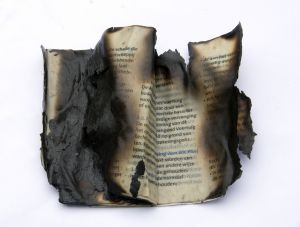Randompedia: Tile Based Games
March 12, 2006
A random draw from the Wikipedia archives:
A tile-based game is a game that uses tiles as one of the fundamental elements of play. It has different meanings depending on how it is used. There are many traditional games which use tiles, but when referring to video games, normally a tile-based game means a game which uses tiles as part of its graphic output.
Traditional games
Traditional tile-based games use small tiles as playing pieces for gambling or entertainment game. Some Board games use tiles to create their board, giving multiple possibilities for board layout.
Each tile has a back (undifferentiated) side and a face side. Tiles are usually rectangular, twice as long as they are wide and at least twice as wide as they are thick, though games exist with square tiles, triangular tiles and even hexagonal tiles.
Traditional Tile-based physical games
- Chinese dominoes games
- Dominoes
- Mahjong (may be played with special playing cards instead)
- Rummikub
- Scrabble
Tile based games that use non-rectangular tiles
Tile-based board games
Video games
A tile-based video game is a type of video or computer game where the playing area consists of small rectangular, square, or hexagonal graphic images, referred to as tiles. The complete set of tiles available for use in a playing area is called a tileset. Tiles are laid out adjacent to one another in a grid; usually, some tiles are allowed to overlap, for example, when a tile representing a unit is overlaid onto a tile representing terrain. Tile-based games usually simulate a top-down or isometric view on the playing area and are almost always two dimensional.
 The European Court of Human Rights has ruled that an infertile woman cannot use her previously fertilized embryos without the consent of her former fiance. Natalie Evans and her fiance undertook the first stages of in vitro fertilization shortly before starting therapy for ovarian cancer that left her infertile in 2001. Evans is now interested in implantation of one of the stored embryos in order to bear a child, however, the couple are no longer together and Evans’ former fiance withdrew consent for the procedure.
The European Court of Human Rights has ruled that an infertile woman cannot use her previously fertilized embryos without the consent of her former fiance. Natalie Evans and her fiance undertook the first stages of in vitro fertilization shortly before starting therapy for ovarian cancer that left her infertile in 2001. Evans is now interested in implantation of one of the stored embryos in order to bear a child, however, the couple are no longer together and Evans’ former fiance withdrew consent for the procedure.
The court’s ruling upholds a British law which stipulates that both of the partners must consent to all stages of the in vitro fertilization process. Evans and a number of pro-life groups have argued that the embryos have a right to life independent of the male partner’s decision.
Link
Glowing Hearts
March 12, 2006
Cornell University researchers have developed genetically engineered mice that have a fluorescent molecule which glows when the heart contracts. The molecule, known as green fluorescent protein (GFP), is derived from bioluminescent jellyfish. It was incorporated into these mice so that the fluorescence is linked to the release of calcium by the muscle cells of the heart. Because the release of calcium is necessary to cause the rhythmic contraction of the heart, the investigators were able to view this process as different areas of the heart began to glow. Their studies have led to new information of embrylogic development of the heart.
There is a nice image from their study on Technovelgy (link below).
 An letter signed by over 200 physicians in the Lancet calls for an end to the forced feeding of Guantanamo detainees who are on hunger strikes, a practice that requires the insertion of a feeding tube. The physicians argue that this amounts to medical therapy and that no competent patient can be subjected to such intervention against their will. A number of medical associations, including the World Medical Association, clearly state that forced feeding is a banned practice.
An letter signed by over 200 physicians in the Lancet calls for an end to the forced feeding of Guantanamo detainees who are on hunger strikes, a practice that requires the insertion of a feeding tube. The physicians argue that this amounts to medical therapy and that no competent patient can be subjected to such intervention against their will. A number of medical associations, including the World Medical Association, clearly state that forced feeding is a banned practice.
From the Physicians for Human Rights website:
Ethical codes endorsed by the American Medical Association (AMA), including the World Medical Association (WMA)’s 1975 Declaration of Tokyo, which was elaborated in the 1991 WMA Declaration of Malta on Hunger Strikers (see links below), state clearly that “where a prisoner refuses nourishment and is considered by the doctor as capable of forming an unimpaired and rational judgment concerning the consequences of such voluntary refusal of nourishment, he or she shall not be fed artificially [emphasis added].�?
Link [Physicians for Human Rights]
Tags: forced, feeding, guantanamo, hunger, strike
 Now this is hot! Scientists from the Sandia National Laboratories in Albuquerque, New Mexico were able to generate the highest temperature ever recorded on Earth, an amazing 3.6 billion degrees Farenheit. The laboratory is part of the U.S. Department of Energy. A snip from the LiveScience.com article:
Now this is hot! Scientists from the Sandia National Laboratories in Albuquerque, New Mexico were able to generate the highest temperature ever recorded on Earth, an amazing 3.6 billion degrees Farenheit. The laboratory is part of the U.S. Department of Energy. A snip from the LiveScience.com article:
Scientists have produced superheated gas exceeding temperatures of 2 billion degrees Kelvin, or 3.6 billion degrees Fahrenheit.This is hotter than the interior of our Sun, which is about 15 million degrees Kelvin, and also hotter than any previous temperature ever achieved on Earth, they say.
Tags: temperature, record, earth, heat, sandia, national, laboratories
Albert Einstein on Curiosity
March 10, 2006
“The important thing is not to stop questioning. Curiosity has its own reason for existing. One cannot help but be in awe when he contemplates the mysteries of eternity, of life, of the marvelous structure of reality. It is enough if one tries merely to comprehend a little of this mystery every day. Never lose a holy curiosity.”
Can Avian Influenza Be Transmitted in Food?
March 10, 2006
 In light of the New York Times report, ‘No Time to Be in the Chicken Business‘, which describes a drop in customers at European restaurants that serve chicken (featured restaurants include Kentucky Fried Chicken and Chicken Corner) since the emergence H5N1 infections in several European countries, I did a bit of fact checking on the method of virus transmission through food products. To date, there have been no documented cases of human avian influenza transmission through cooked poultry according to the World Health Organization. Here is a snip of their current report:
In light of the New York Times report, ‘No Time to Be in the Chicken Business‘, which describes a drop in customers at European restaurants that serve chicken (featured restaurants include Kentucky Fried Chicken and Chicken Corner) since the emergence H5N1 infections in several European countries, I did a bit of fact checking on the method of virus transmission through food products. To date, there have been no documented cases of human avian influenza transmission through cooked poultry according to the World Health Organization. Here is a snip of their current report:
On-going outbreaks of highly pathogenic H5N1 avian influenza in poultry in Asia and, more recently, in Europe have raised concerns about the source of infection and the risk to humans from various exposures. On present evidence, the vast majority of human cases have acquired their infection following direct contact with infected live or dead poultry. WHO is aware of recent concerns that the virus could also spread to humans through contact with contaminated poultry products. To date, no epidemiological data suggest that the disease can be transmitted to humans through properly cooked food (even if contaminated with the virus prior to cooking). However, in a few instances, cases have been linked to consumption of dishes made of raw contaminated poultry blood.
Epidemic of Childhood Obesity on the Rise
March 10, 2006
 The rates of childhood obesity are expected to rise over the next five years to staggering numbers.
The rates of childhood obesity are expected to rise over the next five years to staggering numbers.
In North and South America, it is estimated that just under half of the region’s children will be overweight by 2010, up from about 28 percent. In EU countries, about 38 percent of all children will be overweight should present trends continue _ up from about 25 percent in recent surveys, according to a report published by the International Journal of Pediatric Obesity.
“We have truly a global epidemic which appears to be affecting most countries in the world,” said Dr. Philip James, the chairman of the International Obesity Task Force and the author of an editorial in the journal warning of the trend.
The study lays the blame for this trend on greater access to junk foods and sedentary lifestyles (read as gamers, bloggers, etc.). Public health authorities are concerned that obese kids will, in turn, become obese adults who will suffer from increased rates of heart disease, diabetes, and stroke.
Microsoft Origami Project – The Ultra-Mobile PC
March 9, 2006
 News of the product behind the much hyped Microsoft Origami project was released today. The product is a small keyboardless computer, dubbed the Ultra-Mobile PC, that runs Windows. The machine will have WiFi capabilities (with the option of connecting to a Bluetooth enabled wireless phone so that the internet will never be out of reach) and will offer extensive multimedia support. Evidently, it is intended to be an all-in-one work/entertainment machine.
News of the product behind the much hyped Microsoft Origami project was released today. The product is a small keyboardless computer, dubbed the Ultra-Mobile PC, that runs Windows. The machine will have WiFi capabilities (with the option of connecting to a Bluetooth enabled wireless phone so that the internet will never be out of reach) and will offer extensive multimedia support. Evidently, it is intended to be an all-in-one work/entertainment machine.
Will this be the next big gadget? I’m looking forward to getting my hands on one to try it out.
Undercover Sushi Investigation in L.A.
March 8, 2006
 GotMercury.org, a public health advocacy group, released an undercover investigation of mercury levels in sushi at several popular L.A. restaurants.
GotMercury.org, a public health advocacy group, released an undercover investigation of mercury levels in sushi at several popular L.A. restaurants.
The mercury levels of the 12 tuna samples averaged about double the FDA standard, and a quarter of the orders were near or above the limit where the agency says fish should not be sold, said Eli Saddler, a public health analyst and attorney for GotMercury.org.
Mercury Poisoning (Wikipedia)
Tags: mercury, poisoning, gotmercury.org
Randompedia: Vickers Medium Mark I Tank
March 8, 2006
A random draw from the Wikipedia archives:
Development
After the First World War Britain disbanded most of its tank units: the organic strength was limited to five tank battalions, equipped with the Mark V and the Medium Mark C. A large budget was at first made available for tank design; this was however all spent on the failed development of the Medium Mark D. When in 1923 the state design bureau, the Tank Design Department, was closed, for the time being any direct official involvement in tank development was terminated. But private enterprise had already taken over the torch. Vickers-Armstrong had built two prototypes of a new tank in 1921.
Vickers Light Tank
In 1920 the Infantry had plans to acquire a Light Infantry Tank. Colonel Johnson of the Tank Design Department derived such a type from the Medium Mark D. In competition Vickers built the Vickers Light Tank.
The Vickers design still was reminiscent of the WWI types. It had a high, lozenge-shaped, track frame with side doors. But it also showed some improvements: there was a fully revolving turret and the suspension was sprung by vertical helical springs, while the Medium Mark C still had a fixed turret and was unsprung. The Vickers was really a light tank. It was small vehicle, just seven feet high and weighing only 8.5 short tons. It was driven by a compartimentalised 86 hp engine through an advanced hydraulic Williams-Jenney transmission, allowing infinitely variable turn cycles. The first prototype was a “Female” version with three Hotchkiss machine guns; the second prototype was “Male”, its turret bristling with armament as also a 3-pounder gun and an AA machine gun were added. It had clearly been intended to give the vehicle a modern look: the turret, the front of the fighting compartment and the hull front plate were all strongly rounded. The advanced transmission proved to be utterly unreliable however and the project was abandoned in 1922 in favour of a generally more conventional design: the Vickers Light Tank Mark I, that would in 1924 be renamed to Vickers Medium Tank Mark I. The first prototypes were sent to Bovington for trial in 1923. The Vickers designation was A2E1.
New ‘Furry’ Crustacean Found
March 8, 2006
 French researchers have discovered a new crustacean species that is white with a thick covering of fine fur over its claws and legs. It was discovered in 7,500 feet of water in the South Pacific and is so unusual that it was assigned a new family name, Kiwaida, after the Polynesian goddess of shellfish.
French researchers have discovered a new crustacean species that is white with a thick covering of fine fur over its claws and legs. It was discovered in 7,500 feet of water in the South Pacific and is so unusual that it was assigned a new family name, Kiwaida, after the Polynesian goddess of shellfish.
Tags: furry, shellfish, lobster, crustacean, discovery
Individuals with a mutation of the liver enzyme that metabolizes caffeine appear to be at greater risk for heart attacks when they drink over four cups of coffee per day compared with those who drink less than one cup according to a report in the Journal of the American Medical Association.
day compared with those who drink less than one cup according to a report in the Journal of the American Medical Association.
The team’s results showed that only carriers of the gene mutation for slow caffeine metabolism were at increased risk of heart attack associated with drinking coffee.
For these patients, the increased risk was 64 percent for four or more cups per day over the previous year compared with patients who drank less than one cup per day. The corresponding risk was less than 1 percent for subjects who had two copies of the rapid metabolizing gene.
More Information on Origami
March 7, 2006
Scoble is knocking down readers’ guesses one by one about what the Microsoft Origami actually is. Do you think that you know? Leave a comment on his post. He’ll tell you if you’re right.
Apparently, we’ll all find out on Thursday. Check http://channel9.msdn.com Thursday for more information.
New ASCII Art – Mohammed Smileys
March 6, 2006
Holland To Allow Euthanasia of Children
March 6, 2006
 According to a Sunday Times article, Holland is in the process of establishing regulatory committees to regulate the practice of euthanasia in children who are suffering with incurable diseases. The process is intended to avoid the painful terminal stages of some forms of congenital disease. Physicians embroiled in the controversy over this issue argue that the intent is to provide a humane alternative to suffering for these children. Detractors argue that it is an unethical practice because the children do not have the ability to express their will in the decision. An argument for the practice by Eduard Verhagen, a pediatrician in Groningen who has been at the heart of the controversy, follows:
According to a Sunday Times article, Holland is in the process of establishing regulatory committees to regulate the practice of euthanasia in children who are suffering with incurable diseases. The process is intended to avoid the painful terminal stages of some forms of congenital disease. Physicians embroiled in the controversy over this issue argue that the intent is to provide a humane alternative to suffering for these children. Detractors argue that it is an unethical practice because the children do not have the ability to express their will in the decision. An argument for the practice by Eduard Verhagen, a pediatrician in Groningen who has been at the heart of the controversy, follows:
“If a child is untreatably ill,�? Verhagen explained, “there can be horrendous suffering that makes the last few days or weeks of this child’s life unbearable. Now the question is: are you going to leave the child like that or are you going to prevent that suffering?�? He went on: “Does the child have to sit it out until the end? We think that the answer is no. There can be circumstances where, under very strict conditions, if all the requirements are fulfilled, active ending of life can be an option — but only in cases of untreatable disease and unbearable suffering.�?
It’s not a situation that you would ever like to picture yourself in. But if it were so, could you do it? Could you make the decision to end your young child’s life?
Randompedia: The Newline Character
March 6, 2006
A random draw from the Wikipedia archives:
In computing, a newline is a special character or sequence of characters signifying the end of a line of text. The name comes from the fact that the
next character after the newline will appear on a new line—that is, on the next line below the text immediately preceding the newline. The actual codes representing a newline vary between hardware platforms and operating systems, which can be problematic when exchanging data between systems of different types.
There is also some confusion as to whether newlines terminate or separate lines. If a newline is considered a separator, there will be no newline after the last line of a file. The general convention on most systems is to add a newline even after the last line, i.e. to treat newline as a line terminator. Some programs have problems processing the last line of a file if it isn’t newline terminated. Conversely, programs that expect newline to be used as a separator will interpret a final newline as starting a new (empty) line. This can result in a different line count being reported for the file, but is generally harmless otherwise.
Newlines are sometimes also called line breaks.
Representations
Software applications and operating systems usually represent the newline with one or two control characters:
- Systems based on ASCII or a compatible character set use either LF (Line Feed, 0x0A) or CR (Carriage Return, 0x0D) individually, or CR followed by LF (CR+LF, 0x0D 0x0A).
- EBCDIC systems—mainly IBM mainframe systems, including z/OS (OS/390), i5/OS (OS/400)—use NEL (Next Line, 0x15) as the newline character. Note that EBCDIC also has control characters called CR and LF, but the numerical value of LF differs from the one used by ASCII. Additionally, there are some EBCDIC variants that also use NEL but assign a different numeric code to the character.
- VMS uses a record-based file system and stores text files as one record per line. No line terminators are actually stored, but the system can transparently add a terminator to each line when it is retrieved by an application.
Most textual Internet protocols (including HTTP, SMTP, FTP, IRC and many others) mandate the use of ASCII CR+LF (0x0D 0x0A) on the protocol level, but recommend that tolerant applications recognize lone LF as well. In practice, there are many applications that erroneously use the C newline character '\n' instead (see section Newline in programming languages below). This leads to problems when trying to communicate with systems adhering to a stricter interpretation of the standards; one such system is the qmail MTA that actively refuses to accept messages from systems that send bare LF instead of the required CR+LF.
Unicode
The Unicode standard addresses the problem by defining a large number of characters that conforming applications should recognize as line terminators:
LF: Line Feed, u000A
CR: Carriage Return, u000D
CR+LF: CR followed by LF
NEL: Next Line, u0085FF: Form Feed, u000C
LS: Line Separator, u2028
PS: Paragraph Separator, u2029This may seem overly complicated compared to a simple approach like converting all line terminators to a single character, for example LF. The simple approach breaks down, however, when trying to convert a text file from an encoding like EBCDIC to Unicode and back. When converting to Unicode, NEL would have to be replaced by LF, but when converting back it would be impossible to decide if a LF should be mapped to an EBCDIC LF or NEL. The approach taken in the Unicode standard allows this transformation to be information preserving while still enabling applications to recognize all possible types of line terminators.
History
ASCII was developed simultaneously by the ISO and the ASA, the predecessor organization to ANSI. During the period 1963–1968, the ISO draft standards supported the use of either CR+LF or LF alone as a newline, while the ASA drafts supported only CR+LF. The Multics operating system began development in 1964 and used LF alone as its newline. Unix followed the Multics practice, and later systems followed Unix.
The sequence CR+LF was in common use on many early computer systems that had adapted teletype machines, typically an ASR33, as a console device, because this sequence was required to position those printers at the start of a new line. On these systems text was often routinely composed to be compatible with these printers. The separation of the two functions concealed the fact that the print head could not return from the far right to the beginning of the next line in one-character time. That is why the sequence was always sent with the CR first. In fact, it was often necessary to send CR+LF+NUL (ending with the control character indicating “do nothing”) to be sure that the print head had stopped bouncing. Once these mechanical systems were replaced, the two-character sequence had no functional significance, but it has persisted in some systems anyway.
It has been speculated that QDOS (which Microsoft purchased and renamed MS-DOS) adopted CR+LF to copy the implementation used by CP/M. Further speculation indicates that CP/M chose CR+LF to introduce a deliberate incompatibility with Unix to mitigate a possible lawsuit by AT&T/Bell over violating their Unix copyrights as CP/M was (according to this theory) loosely modeled on UNIX. Others believe this to be unlikely, arguing that CP/M resembles DEC operating systems such as RSTS/E more closely than UNIX. Whatever its source, this convention was inherited by Microsoft’s later Windows operating system.
The Secret of Google’s Ever Expanding Storage Space
March 5, 2006
 Anshuljain managed to obtain access to photos that show how Google is able to offer ever increasing data storage for its gmail service (Click here to see the storage space increase every second). Worrisome to say the least… 🙂
Anshuljain managed to obtain access to photos that show how Google is able to offer ever increasing data storage for its gmail service (Click here to see the storage space increase every second). Worrisome to say the least… 🙂

